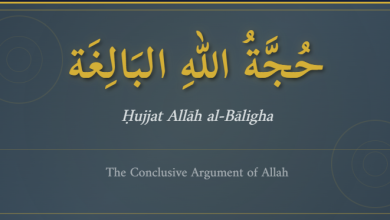Book Review: Abū Bakr al-Bayhaqī’s al-Madkhal ilā ‘Ilm al-Sunan
Book Review: Abū Bakr al-Bayhaqī’s al-Madkhal ilā ‘Ilm al-Sunan
By Muntasir Zaman
[Al-Madkhal ilā ‘Ilm al-Sunan, by Abū Bakr al-Bayhaqī, 2016, 1st ed. Muhammad ‘Awwāmah, pp.969 + 94, vol.2, $35 (hardback), ISBN 978-9933-503-59-8]
Covering nearly one-hundred topics, it is no wonder the disciplines of Hadīth are one of the few sciences that are ‘ripe’ (nadaj) and ‘roasted’ (ihtaraq), that is, they were clearly elucidated and thoroughly researched (al-Jazā’irī, Tawjīh al-Nażar, vol.2, p.903). Obviously, this accomplishment was not the doing of a few scattered scholars; it was the result of relentless effort from an unbroken chain of scholars over a millennium. In his authoritative commentary, Nuzhat al-Nażar, Hāfiż Ibn Hajar al-‘Asqalānī (d. 852 AH) briefly outlines the most prominent installments to the genre of Hadīth nomenclature, starting with al-Ramahurmuzī’s (d. c. 360 AH) al-Muhaddith al-Fāsil and culminating with Abū ‘Amr Ibn al-Salāh’s (d. 643 AH) Ma‘rifat Anwā‘ ‘Ilm al-Hadīth. There is, however, a conspicuous gap as one key figure does not feature on this list: the 5th century Hadīth expert and prolific author, Abū Bakr al-Bayhaqī (d. 458 AH), whose monumental work al-Madkhal ilā ‘Ilm al-Sunan serves prima facie as merely an introduction to his compendium, al-Sunan al-Kubrā, but in essence is a phenomenal work in its own right.
Al-Madkhal was first edited in 1984 by Dr. Diyā’ al-Rahmān al-A‘żamī and published by Dār al-Khulafā’, but it was based on an incomplete manuscript. In 2016, Dār al-Minhāj published the book in two volumes with annotations from Shaykh Muhammad ‘Awwāmah, who cross-examined it with two early manuscripts, one complete and the other partly incomplete. To create awareness of this valuable work, we will briefly summarize its contents, highlight certain salient passages, and examine the editorial work of Shaykh ‘Awwāmah.
Overview
For our purposes, al-Madkhal can broadly be categorized into an introduction and three parts. The introduction comprises an expose of Imām al-Shāfi‘ī’s (d. 204 AH) status as a scholar and mujtahid. Towards the end, the author dedicates several passages to explain the reason for compiling al-Sunan al-Kubrā and the modus operandi of citing hadīths therein (pp.3-45). This is followed by two chapters on the virtues of studying, and the obligation of following, the Qur’ān and the Sunnah, respectively (pp.46-74). The first part covers essential and peripheral discussions concerning Hadīth (pp.75-406). These include introductory topics, such as the authoritativeness of the Sunnah and the veracity of isolated-transmission; it further delves into the disciplines of Hadīth proper with chapters on paraphrased transmission, tadlīs, the traits of a reliable transmitter, and the use of mursal reports. The second part of al-Madkhal covers discussions on legal theory, such as consensus, ijtihad, Mafhūm al-Mukhālafah, and ostensibly conflicting hadīths (pp.407-669). The third part covers the virtues of acquiring knowledge, the rank of scholars, and the etiquettes of students (pp.670-886).
Two sections from the first part are noteworthy. The author spends three chapters to emphasize the reliability of four Companions, ‘Abd Allāh ibn ‘Umar, Abū Hurayrah, Samurah ibn Jundub, and Mu‘āwiyah (Allah be pleased with them) in response to criticisms from certain sects in his hometown, Bayhaq (pp.194-217). Second, the author includes a chapter titled “distinguishing inauthentic hadiths from authentic ones through prolonged exposure [to hadiths] even though the transmitters are trustworthy.” He presents statements from classical scholars on the underlying principle of matn criticism, that is, developing a familiarity with hadīths after long exposure, thereby detecting anomalies (p.263).
The author draws on a plethora of earlier books like Imām al-Shafī‘ī’s oeuvre, Ibn Abī Hātim al-Rāzī’s (d. 327 AH) Adāb al-Shāfī‘ī wa Manāqibuhū, and Ya‘qūb al-Fasawī’s (d. 277 AH) al-Ma‘rifah wa al-Tārīkh. By gathering these scattered passages in one book in a systematic manner, the author made the task easy for students looking for relevant information, not to mention countless quotes that are not easily found in any extant source. It is worth noting that he rendered a great service by preserving priceless quotes from al-Fasawī’s Tārīkh not found in the printed edition of the book.
Annotations
Avid readers of Shaykh ‘Awwāmah’s works might have expected more detailed footnotes. But as he himself explains, his primary focus was to accurately compare the available manuscripts of the work and reference the citations therein (p.25). As expected, he fulfilled both tasks with the scholarly brilliance characteristic of his other works. He states in no uncertain terms that he will not expend energy in analyzing issues related to the differences of the legal schools, whether peripheral rulings or legal theory. Bearing in mind that the author was a Shāfi‘ī scholar and that the purpose of writing al-Sunan al-Kubrā was to augment Shafī‘ī substantive law with hadīths, it is understandable that al-Madkhal incorporates material that tilts the balance in favor of the author’s legal school. The editor makes the apt observation that to stubbornly hold onto any position that falls within the scope of legitimate difference of opinion as definite is untenable. Therefore, there is no point of engaging in polemics (p.27).
On a number of occasions, he simply refers the reader to his tour de force, his marginal notes on Jalāl al-Dīn al-Suyūtī’s (d. 911 AH) Tadrīb al-Rāwī. Under the chapter on the narrations of the people of Iraq, for instance, he briefly explains that negative remarks mentioned in this chapter were addressed regarding a specific group and era. These remarks should not be seen as a general attitude towards the narrations of the people of Iraq. He then refers the reader to his footnotes on Tadrīb al-Rāwī for more details (p.343). Be that as it may, the book is interspersed with beneficial footnotes. Brief comments include the following:
- Dāwūd ibn ‘Alī al-Zāhirī (d. 270 AH), the founder of the Zāhirī legal school, was the first to pen an independent biography of Imām al-Shāfi‘ī (p.9).
- In principle, ‘Abd al-Rahmān heard from his father, ‘Abd Allāh ibn Mas‘ūd (p.67).
- The title of Ibn Hajar’s introduction to his magnum opus, Fath al-Bārī, is correctly vowelized as Hudā al-Sārī instead of Hady al-Sārī (p.615).
- Al-Bayhaqī’s observation that authentic hadīths suffice one from consulting weak ones refers to weak hadiths that also have problematic content (p.618).
- The chapter headings of Hadīth compilations are themselves a form of commentary for hadīths, albeit brief and subtle (p.749).
- Al-Hākim al-Naysābūrī (d. 405 AH) uses the phrase “al-isnād al-mubham” to refer to an interrupted chain of transmission (p.809).
There are only a handful of lengthy comments, two of which are noteworthy. The first is a defense of Ibn Mas‘ūd against claims that he erred in, or was unaware of, several issues. Shaykh ‘Awwāmah points out that since Ibn Mas‘ūd was an authority in his own right, it is incorrect to fault him for independently holding certain views; in fact, he should be praised for singlehandedly preserving the teachings of the Prophet (peace be upon him). He emphasizes that some of these opinions were shared by other scholars as well while some of these views are not reliably attributed to him to begin with. By way of illustration, he analyzes reports concerning Ibn Mas‘ūd’s exclusion of the mu’awwidhatayn from his copy of the Qur’ān. It is widely related that Ibn Mas‘ūd taught these sūrahs to his students, as transmitted via six of the ten modes of Qur’ānic recitation. Hence, notwithstanding that the chains of these reports may be authentic in the technical sense, their content is problematic. Alternatively, these reports should be interpreted to mean, as Ibn Hajar explains, Ibn Mas‘ūd only refused to write the mu’awwidhatayn in his mushaf, but in no way did he refuse to accept them as part of the Qur’ān (p.348).
Second, he comments on al-Bayhaqī’s negative remarks on the hadīth “Indeed, hadiths will spread after me. Thus, whatever is attributed to me that corresponds to the Qur’ān, then it is from me, and whatever is attributed to me that conflicts with the Qur’ān, then it is not from me.” Shaykh ‘Awwāmah makes four observations here: (1) by saying “this is munqati‘” al-Bayhaqī means it is mursal, and three of the four Imāms regard mursal hadiths as legally binding when it is void of other isnād or matn related flaws; (2) the unidentified narrator in the chain is not Khālid ibn Abī Karīmah; (3) this is a good example of why a researcher needs to consult the primary source of a quote and contextualize it [he quotes the entire passage from Qādī Abū Yūsuf’s (d. 182 AH) al-Rad ‘alā Siyar al-Awzā‘ī where the hadith is cited to illustrate]; and (4) although al-Bayhaqī states that all the routes of transmission for this hadīth are unreliable, the question remains whether they can potentially reach the level of extrinsically sound (hasan li ghāyrīhī) in view of their multiplicity; scholars throughout the ages have searched for support in the Qur’ān for weak hadiths—al-Bayhaqī himself engages in this practice. He concludes by noting how the disparity in scholarly attitudes towards this hadith demonstrates that one’s understanding of a hadīth directly influences how one will grade its authenticity, and he refers readers to, among others, Abū Ja‘far al-Tahawī’s (d. 321 AH) treatment of the hadith in Sharh Mushkil al-Athār (p.132).
Conclusion
In sum, al-Bayhaqī’s al-Madkhal ilā ‘Ilm al-Sunan is a treasure trove of useful information, backed with chains of transmission to the respective sources and organized in an accessible fashion. Furthermore, the editor has cross-examined reliable manuscripts to present an accurate representation of the book, referenced the relevant passages to their primary sources, and provided useful comments throughout the two-volume work. Given the fast rate with which classical texts are being published these days, it is understandably difficult for students to keep abreast with the influx of titles in the market. However, al-Madkhal should not escape the attention of serious students of Hadīth interested in developing a strong foundation in the field.







Assalamu alaikum
May Allah bless Shaykh Muhammad Awwama and give him a long life to benefit us all. Amin